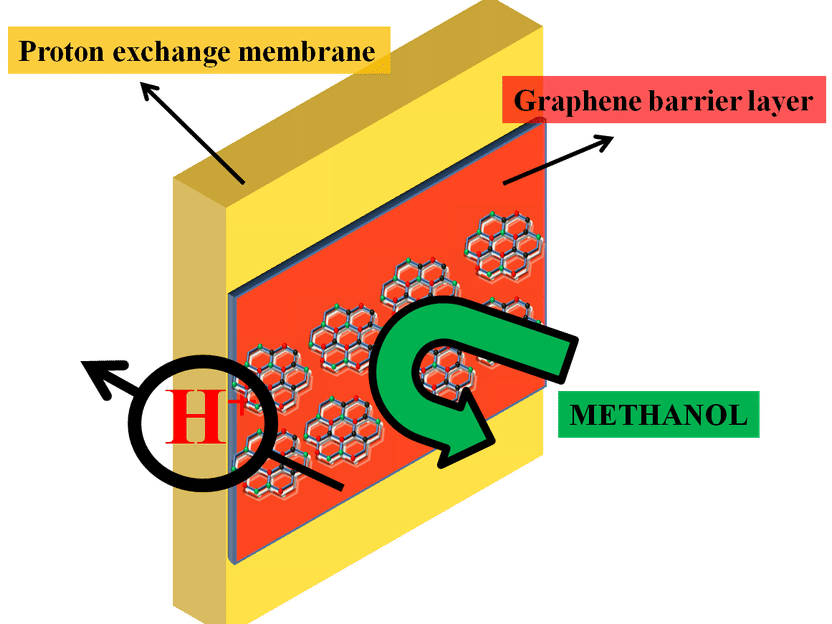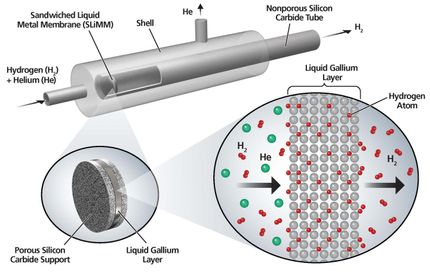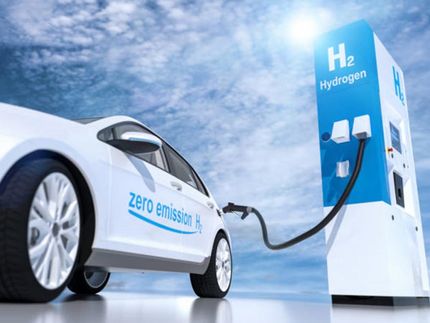Enhancing fuel cell performance with graphene
Exploiting the usage of 2 D crystals in methanol fuel cells
Scientists from the School of chemical engineering and Analytical Science, in the University of Manchester have come up with a way to utilize 2D materials in an actual operating direct Methanol fuel cell. They have shown that the addition of single layer graphene by Chemical vapour deposition, on to the membrane area has significantly reduced the methanol cross over at the same time obtaining negligible resistance to protons thereby enhancing the cell performance by 50%.

Schematic representation of proton transport through the membrane region of methanol fuel cells
The University of Manchester
Fuel cells count as interesting energy technology of the near future, as they pave the way for the production of sustainable energy using simple hydrocarbons as fuels. They work by a simple operational mechanism with the fuel oxidation on one side, and oxidant reduction on other side, which liberates electrons used for electrical energy generation. A wide variety of fuels, short chain alcohols have been used so far. Methanol remains a favourable candidate due to its high energy density, ease of handling and other operational characteristics.
Hence methanol fuel cells find their potential use in laptop chargers, military applications or other scenarios where the access to electricity is difficult. However the wider spectrum of commercial potential for methanol systems is greatly hindered by the methanol cross over occurring in the membrane area of fuel cells.
This passage of methanol from anode to the cathode through the membrane, creates short circuit and affects the fuel cell performance negatively. This is mitigated by using a barrier layer, in addition to the membrane used.
Andre Geim and his co-workers discovered the proton transfer through the single layer graphene and other 2D materials. Graphene is also known for its dense lattice packing structure, inhibiting the passage of methanol and other hydrocarbons based molecules across the membrane. However the actual application of these 2D materials, in fuel cell systems has not yet been realized.
Previous work in this field also tested different materials that yielded improved performance by reducing the methanol crossover, but these also significantly reduced proton transport, as opposed to this work in which it remained unharmed. This would be of significant interest, as this would lead to usage of 2D materials in fuel cells.
Moreover, this gives the opportunity for membrane less fuel cell system operating with higher efficiency in the near future. This technology could further be extended to other fuel cells types namely hydrogen fuel cells. Hydrogen fuel cells, suffer from the usage of high cost humidifier, as these membranes need to be humidified for improved proton conductivity.
Whereas graphene showed improved proton conductivity with temperature, without the need for humidifier systems. The future prospect could be realized in such a way that the fuel cells will make significant contribution to the future energy demand.
Original publication
Other news from the department science
These products might interest you

Anopore™ by Cytiva
Precise filtration made easy with Anopore inorganic membranes
The aluminum oxide filter membrane that can increase the purity or yield of your analyte

Hahnemühle LifeScience Catalogue Industry & Laboratory by Hahnemühle
Wide variety of Filter Papers for all Laboratory and Industrial Applications
Filtration Solutions in the Life Sciences, Chemical and Pharmaceutical Sectors

Get the chemical industry in your inbox
By submitting this form you agree that LUMITOS AG will send you the newsletter(s) selected above by email. Your data will not be passed on to third parties. Your data will be stored and processed in accordance with our data protection regulations. LUMITOS may contact you by email for the purpose of advertising or market and opinion surveys. You can revoke your consent at any time without giving reasons to LUMITOS AG, Ernst-Augustin-Str. 2, 12489 Berlin, Germany or by e-mail at revoke@lumitos.com with effect for the future. In addition, each email contains a link to unsubscribe from the corresponding newsletter.



























































